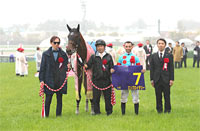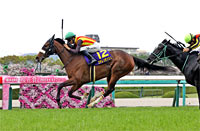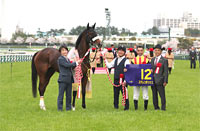2016 News
Data Analysis for the "2016 Oka Sho (Japanese 1000 Guineas) (G1)"Classic opener for fillies, a birthplace of new legends Now at last, the 2016 classic season takes off. The contest to grace this key moment in the racing year is the Oka Sho (Japanese 1000 Guineas), a race for 3-year-old fillies. Looking back over results from the last 10 years, the favorite has triumphed on three occasions, but so have fillies backed as 6th favorite or lower; there has been no lack of surprises. So which filly will bathe in the glory of success this time? As we approach this pulsating contest, let’s delve into some statistics shared by successful performers in past years. Check the distance of the last 2 races If we look at aggregate performances of runners over the last 10 years in terms of their most recent appearances, we find that all of the winners in that time had experienced starts in turf 1,600m races within their previous two outings. In fact, all 7 winners since 2009 had run in turf 1,600m races in both of their previous two outings. And all 10 runners-up had also appeared in at least one turf 1,600m race within their previous two starts. So before all else, we should be looking for runners with experience of contesting turf 1,600m races within their previous two outings. [Table 1] [Table 1] Performance by appearances in turf 1,600m races within previous two outings (last 10 years)
Winners last time out dominate, but as for the others… Turning next to the runners’ performances by their most recent finish over the last 10 years, all 10 winners had finished within the top 4 in their previous race. Of the 10 runners-up, meanwhile, 7 had won their last race, but the other 3 had been beaten to 6th or lower. Another fact that might be worth remembering is that, of 9 top 2 finishers placed “2nd or lower” last time out, 7 had contested the “Tulip Sho”. [Table 2] [Table 2] Performance by finish in previous race (last 10 years)
Strong showing by horses with few non-top 3 finishes Viewing performances of runners over the last 10 years in terms of finishes of 4th or lower in JRA races, those with “0” finishes outside the top 3 have standout figures, including a top 3 ratio of 42.5%. Generally, in fact, success ratios tend to be higher for fillies with fewer finishes of 4th or lower. This year, too, we should pin greater hopes on horses with few finishes outside the top 3 since their debut. [Table 3] [Table 3] Performance by finishes of 4th or lower in JRA races (last 10 years)
Check finish in the race following the maiden win On the performance of runners over the last 10 years by their finish in the race following their maiden win, 15 of the 20 top 2 finishers in the Oka Sho had also won the race immediately after their maiden win. Of the remaining five, three had finished “2nd or 3rd in turf graded races” next time out, and all of these were Oka Sho winners. In other words, no horse beaten to 2nd or lower in anything other than a JRA turf graded race in the race following her maiden win has won the Oka Sho over the last 10 years. It might be an idea to check the runners’ finish in the race immediately following their maiden win. [Table 4] [Table 4] Performance by finish in race following maiden win (last 10 years)
Seek out the winner! Of the last 9 winners since 2007, 6 had come to this race with “a top 7 finish and top 7 favoritism in the Hanshin Juvenile Fillies” and the other 3 with “a top 3 finish and top 6 favoritism in the Shinzan Kinen”. This year, too, we ought to check whether the runners entered the Hanshin Juvenile Fillies or Shinzan Kinen and had similar backing and finishes to those mentioned above. [Table 5] [Table 5] Performance and favoritism of Oka Sho winners in the Hanshin JF or Shinzan Kinen (last 9 years)
(Michio Kawano) |

|



















